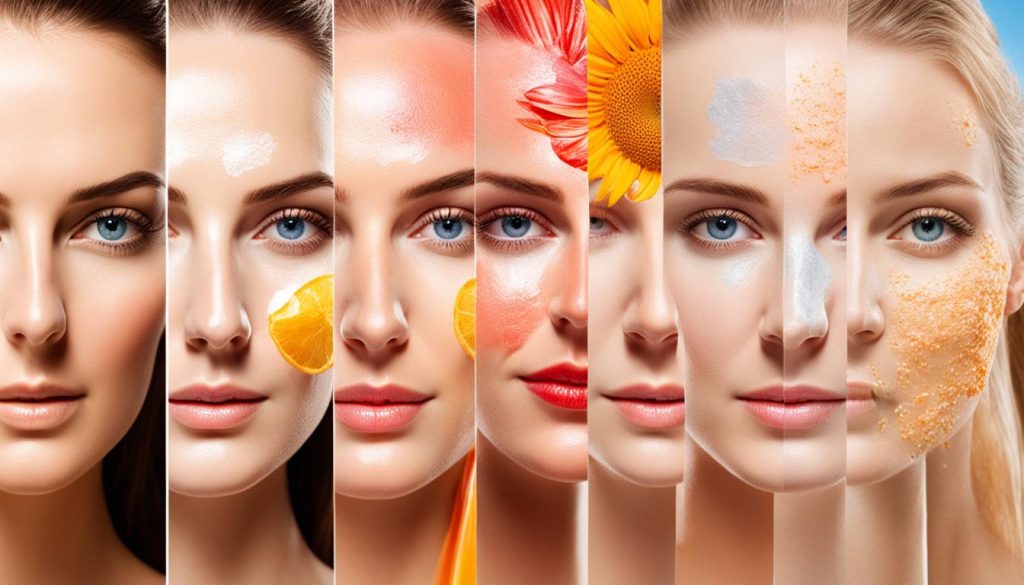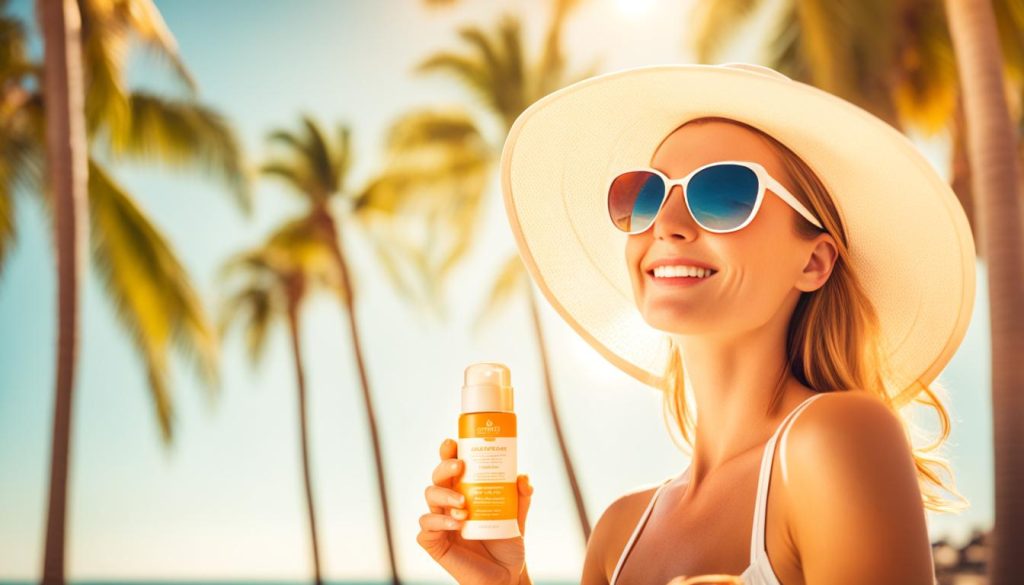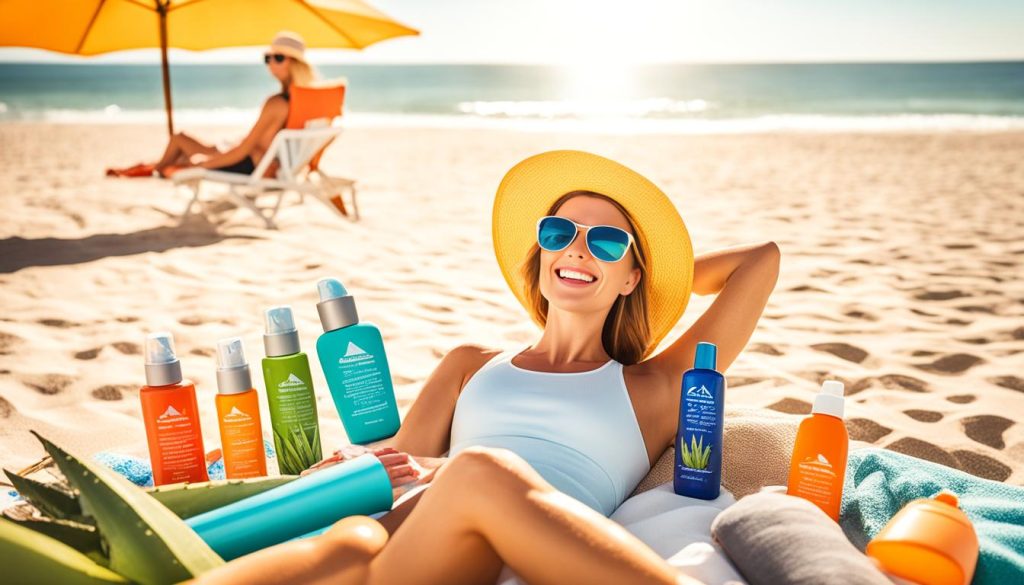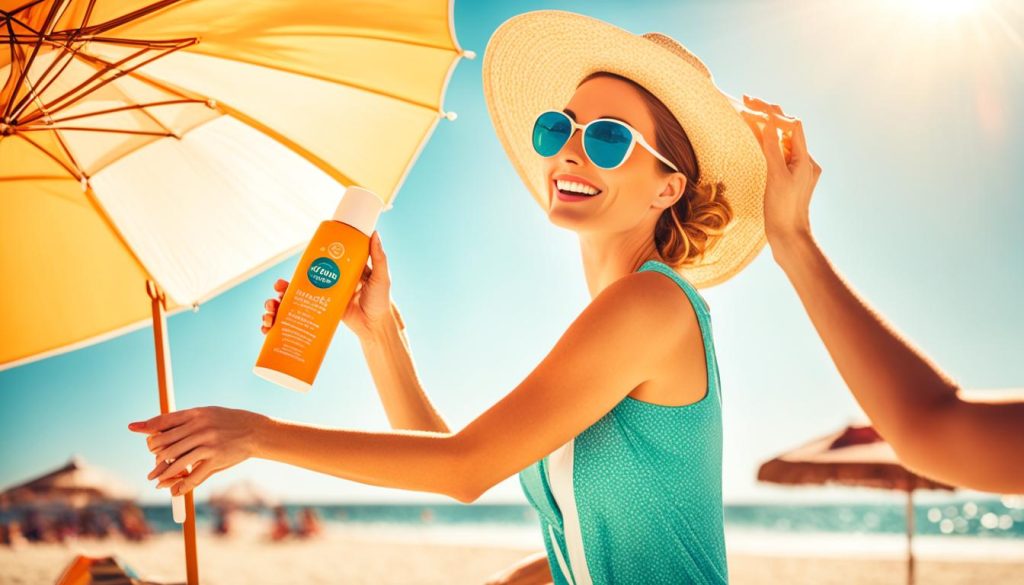As days get longer and the sun calls us outside, we feel the excitement of summer. We dream of beach days, barbecues, and sunlit moments. But, the sun also brings UV radiation, a powerful force we must protect against.
Every year, many people enjoy the sun without thinking about the dangers. Yet, skin cancer affects one in five Americans by age 70. As summer approaches, protecting your skin from the sun is crucial.
Using the right sun protection can save you from skin damage. Sunburn, wrinkles, and skin cancer are serious risks. Let’s take care of our skin this summer, enjoying the sun safely.
Understanding UV Radiation and Its Effects on Skin
The sun sends out different kinds of ultraviolet (UV) radiation. These can harm the skin in just 15 minutes. Knowing about these types is key for good summer skincare and protecting against UV rays.
UVA and UVB rays are the main types of UV radiation. UVA rays go deep into the skin, causing collagen to break down. This leads to premature aging, wrinkles, and a higher risk of skin cancer.
On the other hand, UVB rays hit the skin’s outer layers. They cause sunburns, tanning, and sunspots. Too much UVB can increase the risk of skin cancer.

Studies show that too much UV exposure can have serious effects. Severe sunburns early in life can raise the risk of melanoma, the most dangerous skin cancer. While basal cell and squamous cell carcinomas are less severe, they make up 95% of skin cancer cases. Catching them early can help treat them effectively.
People with fair skin, light eyes, and easily burning hair are more at risk for skin cancer. But, even those with darker skin tones can still be at risk, though less so. Other factors include a family history of skin cancer, outdoor work, living in sunny places, and having had severe sunburns.
To protect against UV rays, use sunscreen with SPF 30 or higher, wear protective clothing, and follow sun safety tips. This is crucial, especially when spending more time outdoors in the summer.
Why Sun Protection is Essential in Summer
Summer brings more sun and longer days, making us more exposed to the sun’s harmful effects. Activities outside increase our risk of getting sun damage. The sun’s rays are strongest between 10 AM and 4 PM, raising the chance of skin harm.
Using sun protection tips is vital for keeping skin healthy. Too much sun can cause sunburn, aging, wrinkles, and increase skin cancer risk. Sadly, skin cancer is the most common cancer in the U.S., costing over $100 million in lost productivity each year.
Using sunscreen is a top way to protect your skin in summer. Choose a sunscreen with at least SPF 30 for kids over six months old. This level blocks up to 97% of UVB rays, which are more cancer-causing than UVA rays, which mainly cause aging. Apply sunscreen every two hours, or more if you swim or sweat.

Other than sunscreen, sunglasses with UV protection and protective clothing help shield you. Knowing the UV Index helps plan safe outdoor activities. Keeping these tips in mind ensures better skin protection in summer, making it a season to enjoy safely.
Summer is Coming: How to Protect Your Skin from the Sun?
As summer approaches, it’s key to know how to shield your skin from the sun. Begin with applying broad-spectrum sunscreen daily, aiming for an SPF of 30 or higher. This is vital since most sun exposure happens during everyday outdoor activities. Remember, you need about 1 ounce of sunscreen to cover your face, neck, arms, and legs properly.

For best results, reapply sunscreen every two hours. If you’re swimming or sweating, do it even more often. Besides sunscreen, wear protective clothing like long-sleeved shirts, long skirts, and pants. These items offer better UV protection than lighter clothes. Dark-colored fabrics also shield more effectively against UV rays.
Choose hats with a wide brim for extra protection. And don’t forget sunglasses that block 100% of UV rays. Try to stay in the shade, especially between 10 am and 4 pm when the sun’s rays are strongest. If you can, use an umbrella or stay under a tree during these hours.
Don’t forget to apply lip balm with UV protection to keep your lips moisturized. Talk to your doctor about any medications that could make your skin more sensitive to the sun. Avoid sunbathing, especially if you have fair skin, as it can be risky.
| Protection Measure | Recommendation |
|---|---|
| Broad-spectrum Sunscreen | SPF 30 or higher |
| Reapplication Frequency | Every 2 hours, more if swimming/sweating |
| Protective Clothing | Long sleeves and dark colors |
| Hat Type | Wide-brimmed (2-3 inches) |
| Sunglasses | 100% UV protection |
| Peak Sun Hours | 10 am – 4 pm |
By following these tips, you can protect your skin as summer arrives. Stay informed and proactive to enjoy the outdoors safely.
Choosing the Right Sunscreen for Summer
Finding the right sunscreen is key to protecting your skin from the sun’s harmful rays. Over half of Americans don’t use sunscreen often. Knowing what to look for can help you take good care of your skin this summer. The best sunscreen for summer should protect against both UVA and UVB rays.
What to Look for in a Sunscreen
When picking a sunscreen, keep these things in mind:
- Broad-Spectrum Protection: This means it guards against both UVA and UVB rays, which helps prevent skin damage.
- SPF Rating: Choose at least SPF 30, which blocks 97% of UV rays. Higher SPFs offer a bit more protection.
- Skin Type Considerations: If your skin is sensitive, go for mineral sunscreens. For water resistance, chemical options might be better.
Importance of Broad Spectrum Protection
Broad-spectrum sunscreen is vital because it protects against UVA rays, which go deep into the skin and can cause skin cancer and premature aging. It also guards against UVB rays, which mainly affect the skin’s surface. Choosing a sunscreen that offers broad-spectrum protection can significantly lower the risk of skin damage when you’re outside.
SPF Ratings Explained
The SPF rating tells you how well the sunscreen protects. For example, SPF 15 blocks 93% of UVB rays, and SPF 50 blocks 98%. Dermatologists suggest using at least SPF 30 and reapplying every two hours for the best protection. But remember, no sunscreen is waterproof; they’re only water-resistant for a short time.
How to Apply Sunscreen Effectively
Learning the best ways to apply sunscreen is key to protecting against harmful UV rays. It’s important to put on sunscreen generously and often for the best protection.
Recommended Amounts and Techniques
An average adult or child needs about one ounce of sunscreen, like a shot glass full. This amount is crucial for covering the entire body from head to toe. For certain areas:
- Face and neck: About half a teaspoon.
- Arms and legs: One ounce for both arms and both legs.
Put sunscreen on 15-30 minutes before going outside. Use smooth strokes and make sure to cover all skin, including ears, the back of the neck, and the tops of feet. Don’t forget about often-missed spots.
When and How Often to Reapply
Reapplying sunscreen is key to keeping it working well. You should put it on again every two hours, or right after swimming or sweating a lot. If a sunscreen says it’s “water resistant,” check how long it lasts in water, 40 minutes or 80 minutes.
Remember, makeup with SPF might not be enough for sun protection. You should also use sunscreen separately.
Using sunscreen correctly can greatly lower the risk of skin damage and make summers more fun. Always check the expiration dates to make sure your sunscreen is still good and follows FDA rules.
Protective Clothing and Accessories
Adding protective clothing and accessories to your summer skincare routine is key for UV protection. Certain fabrics and styles can greatly reduce your risk of harmful rays. By choosing wisely, you can enjoy the sun while keeping your skin safe.
Choosing the Best Fabrics for UV Protection
Look for clothing with a high Ultraviolet Protection Factor (UPF) rating when picking out your summer clothes. A UPF of 30 is the lowest rating to get The Skin Cancer Foundation’s Seal of Recommendation. Ratings from 30 to 49 offer very good protection, and UPF 50+ is excellent.
Dark or bright colors absorb UV rays better than light ones. Densely woven fabrics like denim, canvas, and wool block harmful rays more effectively than sheer ones.
The Importance of Hats and Sunglasses
Hats and sunglasses are key for full UV protection. A hat with a 3-inch brim or more covers your face, neck, and ears. Choose sunglasses that block 99 to 100% of UVA and UVB light to protect your eyes.
Using sun-protective clothing with these accessories will keep you well-protected from the sun.
| Fabric Type | UPF Rating | Protection Level |
|---|---|---|
| Denim | Up to 1,700 | Excellent |
| Unbleached Cotton | Varies | Good |
| Shiny Polyester | High | Good to Excellent |
| Regular T-shirt | 7 | Moderate |
Other Sun Safety Tips to Consider
Protecting your skin is more than just about sunscreen. Using good sun safety tips helps you fight UV rays, especially in summer. Simple steps can keep your skin healthy.
Avoiding Sun Exposure During Peak Hours
Experts say to stay out of the sun during the hottest part of the day, from 10 AM to 4 PM. This is when UV rays are strongest. If you must be outside, plan activities for early morning or late afternoon.
Use shade under umbrellas, trees, or made-up areas. A portable shade can be a great tool for staying safe. This approach reduces UV rays and supports sunscreen and protective clothes.
Seeking Shade Effectively
It’s key to find shade to stay safe from the sun. Workplaces and homes should have shaded spots. When outside, look for tree canopies or awnings.
Being smart about where you sit can cut down on sun exposure. UV rays can bounce off water and sand, upping your sunburn risk. Always look for shade to safely enjoy the outdoors and lower your skin damage risk.
Incorporating a Summer Skin Care Routine
Every summer, your skin faces new challenges. It’s key to adjust your skin care to keep it healthy and glowing. Start with moisturizing and hydration to protect your skin from the heat.
Moisturizing and Hydration
Moisturizing is crucial to fight dryness from the sun. Look for products with omega-3 and omega-6 fatty acids. Don’t forget to use sunscreen with SPF 30 and reapply every two hours.
Adding a vitamin C serum can protect your skin from damage and brighten it.
Sun-kissed Skin: The Call for Self-Tanners
If you want a sun-kissed look without UV risks, try self-tanners. They’re a safer way to get a glow. Use serums with licorice root or kojic acid to balance your skin tone.
Drinking eight glasses of water a day will also improve your skin’s look.
| Skin Care Element | Description | Frequency |
|---|---|---|
| Moisturizer | Hydrates and protects skin | Daily |
| Sunscreen (SPF 30+) | Blocks harmful UV rays | Every 2 hours |
| Vitamin C Serum | Brightens and protects skin | Daily |
| Gentle Exfoliation | Removes dead skin cells | 2-3 times a week |
| Self-tanner | Achieves a summer glow | As needed |
The Risks of Tanning Beds and Alternatives
As summer approaches, it’s important to know how to protect your skin from the sun. Tanning beds are often seen as a safer choice than sun exposure. But, this belief can be dangerous. Tanning beds give off harmful UV rays, raising the risk of skin cancer, including melanoma.
Studies show a worrying trend. Starting to use tanning beds before turning 35 increases the risk of melanoma by 75%. One in five Americans will get skin cancer by the time they are 70. In fact, more people get skin cancer from tanning beds than from smoking-caused lung cancer. UVA rays from tanning beds go deeper into the skin, causing tanning and aging.
It’s shocking to learn that 97% of women under 30 with melanoma used tanning beds. Clearly, tanning beds are not a safer choice than sunbathing outside. Instead, try self-tanning products to get a sun-kissed look without the risks.
But the risks of indoor tanning go beyond skin cancer. It can lead to cataracts and eye cancers, showing the need for protection. A tan is actually a sign of skin damage from UV rays, not health. Over time, using tanning beds can cause more DNA mutations.
Here’s a summary of the risks associated with tanning beds:
| Risk Factor | Details |
|---|---|
| Increased Cancer Risk | 75% increase in melanoma risk if tanning begins before 35 |
| Skin Cancer Statistics | 1 in 5 Americans will develop skin cancer by age 70 |
| UVA Ray Penetration | UVA rays penetrate deeper, causing aging and skin damage |
| Accidents and Injuries | Over 3,000 people visit ER annually due to tanning-related injuries |
| Classification by WHO | Indoor tanning devices are classified as carcinogenic |
Checking Your Skin Regularly
Checking your skin often is key to keeping it healthy, especially in summer when UV rays are stronger. It’s important to watch for any changes to protect your skin. Catching issues early can make a big difference in treatment success.
Identifying Changes and Potential Issues
Do a self-check every month to notice any new moles or changes in old ones. The ABCDE rule can help spot melanoma:
- Asymmetry: One half of the mole does not match the other.
- Border: Edges are irregular, ragged, or blurred.
- Color: The color is not uniform and may include shades of brown, black, or even pink.
- Diameter: The mole is larger than six millimeters.
- Evolving: The mole changes in size, shape, or color over time.
Also, see a dermatologist once a year for a check-up. This is a good idea if you have skin cancer history or many moles. Skin cancer is common, affecting about 1 in 5 Americans. Catching it early can really help.
Use one ounce of sunscreen on your skin to get the SPF you need. Put it on every two hours to keep it working well. Choose a physical sunscreen with SPF 30 or higher for the best protection this summer.
| Skin Exam Frequency | Reason |
|---|---|
| Monthly | Self-exams for changes in moles |
| Annually | Dermatologist check-up for at-risk individuals |
| Semi-annually or more | Patients with a history of skin cancer |
| Every few years | Patients with moles or lesions under observation |
How Medications Can Affect Sun Sensitivity
Many people don’t know that some medicines make their skin more sensitive to the sun. This can lead to sunburn. Over 15 types of medicines, from common antibiotics to prescription retinoids, can cause this sensitivity. People taking these medicines should be extra careful with sun protection.
Some medicines that make you more sensitive to the sun include:
- Antibiotics such as Bactrim, Doxycycline, and Tetracycline.
- Prescription retinoids like Retin-A and Tazorac.
- Non-steroidal anti-inflammatory drugs (NSAIDs) such as ibuprofen and naproxen.
- Oral antihistamines like diphenhydramine, which may impair sweating, heightening the risk of overheating.
- Various antidepressants, which can manifest symptoms like red, itchy spots when exposed to sunlight.
Other things can also make you more sensitive to the sun. This includes autoimmune conditions like lupus and living in places with lots of UV rays. Things like sunlamps and phototherapy lamps can also make it worse.
To reduce the risks from these medicines, follow these sun protection tips:
- Stay indoors during peak sun hours, from 10 a.m. to 4 p.m.
- Seek shade whenever possible.
- Wear protective clothing, including hats and long-sleeves.
- Use a broad-spectrum sunscreen with an SPF of at least 30, reapplying every two hours, especially after swimming or sweating.
Talk to your healthcare provider about the medicines you take, especially those that make you more sensitive to the sun. Taking these steps can help keep your skin healthy while you enjoy the outdoors this summer.
Conclusion
As summer comes closer, it’s crucial to focus on protecting your skin from UV rays. Knowing how UV rays affect your skin is key. By choosing a broad-spectrum sunscreen with the right SPF, wearing protective clothes, and following sun safety tips, you can enjoy the sun safely.
Hydrating your skin and applying sunscreen correctly are also important. Eating foods rich in antioxidants and omega-3 fatty acids helps protect your skin too. Don’t forget to drink at least eight glasses of water a day to keep your skin hydrated.
Regular skin checks and knowing how medications affect your skin sensitivity are part of a strong sun protection plan. With these steps, your skin can stay healthy and glowing, even when the sun is strongest. Enjoy the summer while keeping your skin safe with these key tips!


